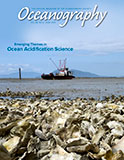Article Abstract
The continental shelves of the Pacific-Arctic Region (PAR) are especially vulnerable to the effects of ocean acidification (OA) because the intrusion of anthropogenic CO2 is not the only process that can reduce pH and carbonate mineral saturation states for aragonite (Ωarag). Enhanced sea ice melt, respiration of organic matter, upwelling, and riverine inputs have been shown to exacerbate CO2 -driven ocean acidification in high-latitude regions. Additionally, the indirect effect of changing sea ice coverage is providing a positive feedback to OA as more open water will allow for greater uptake of atmospheric CO2 . Here, we compare model-based outputs from the Community Earth System Model with a subset of recent ship-based observations, and take an initial look at future model projections of surface water Ωarag in the Bering, Chukchi, and Beaufort Seas. We then use the model outputs to define benchmark years when biological impacts are likely to result from reduced Ωarag. Each of the three continental shelf seas in the PAR will become undersaturated with respect to aragonite at approximately 30-year intervals, indicating that aragonite undersaturations gradually progress upstream along the flow path of the waters as they move north from the Pacific Ocean. However, naturally high variability in Ωarag may indicate higher resilience of the Bering Sea ecosystem to these low-Ωarag conditions than the ecosystems of the Chukchi and the Beaufort Seas. Based on our initial results, we have determined that the annual mean for Ωarag will pass below the current range of natural variability in 2025 for the Beaufort Sea and 2027 for the Chukchi Sea. Because of the higher range of natural variability, the annual mean for Ωarag for the Bering Sea does not pass out of the natural variability range until 2044. As Ωarag in these shelf seas slips below the present-day range of large seasonal variability by mid-century, the diverse ecosystems that support some of the largest commercial and subsistence fisheries in the world may be under tremendous pressure.

